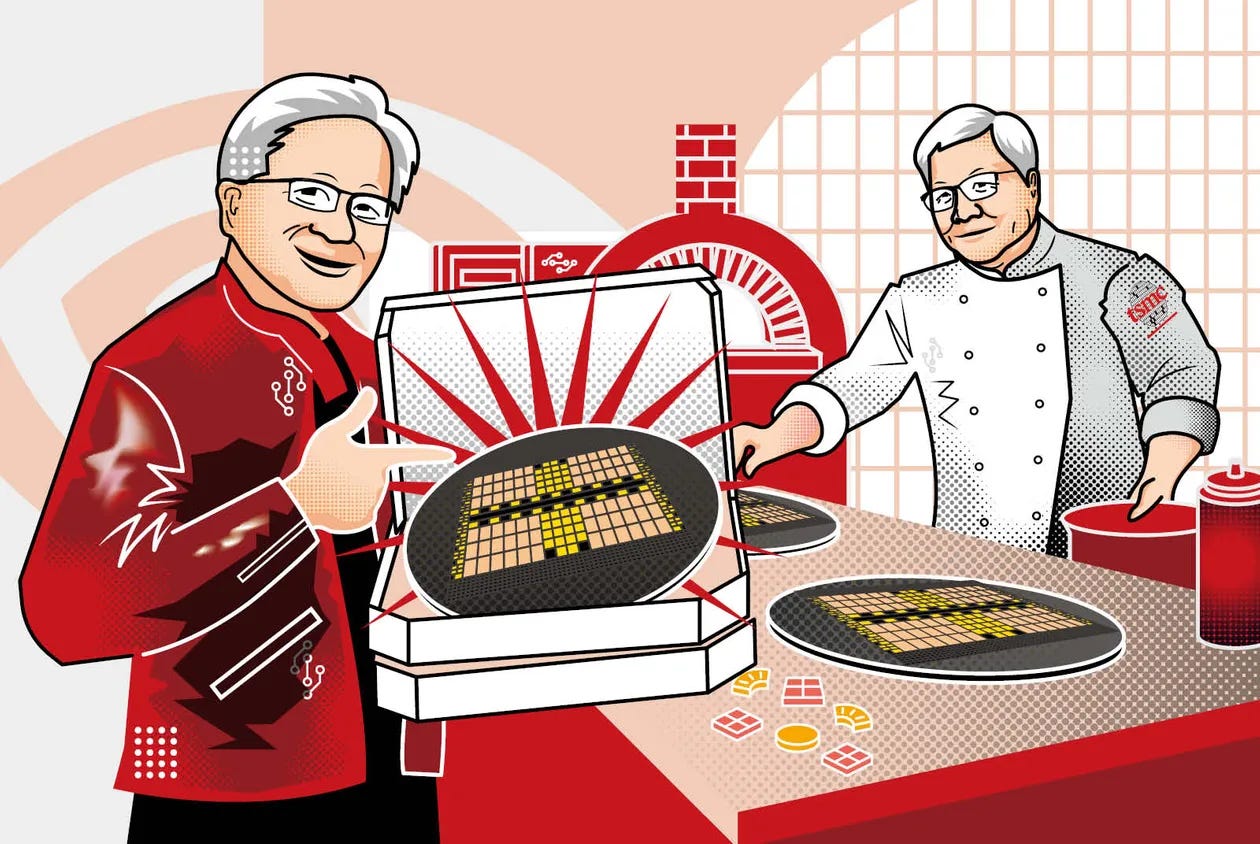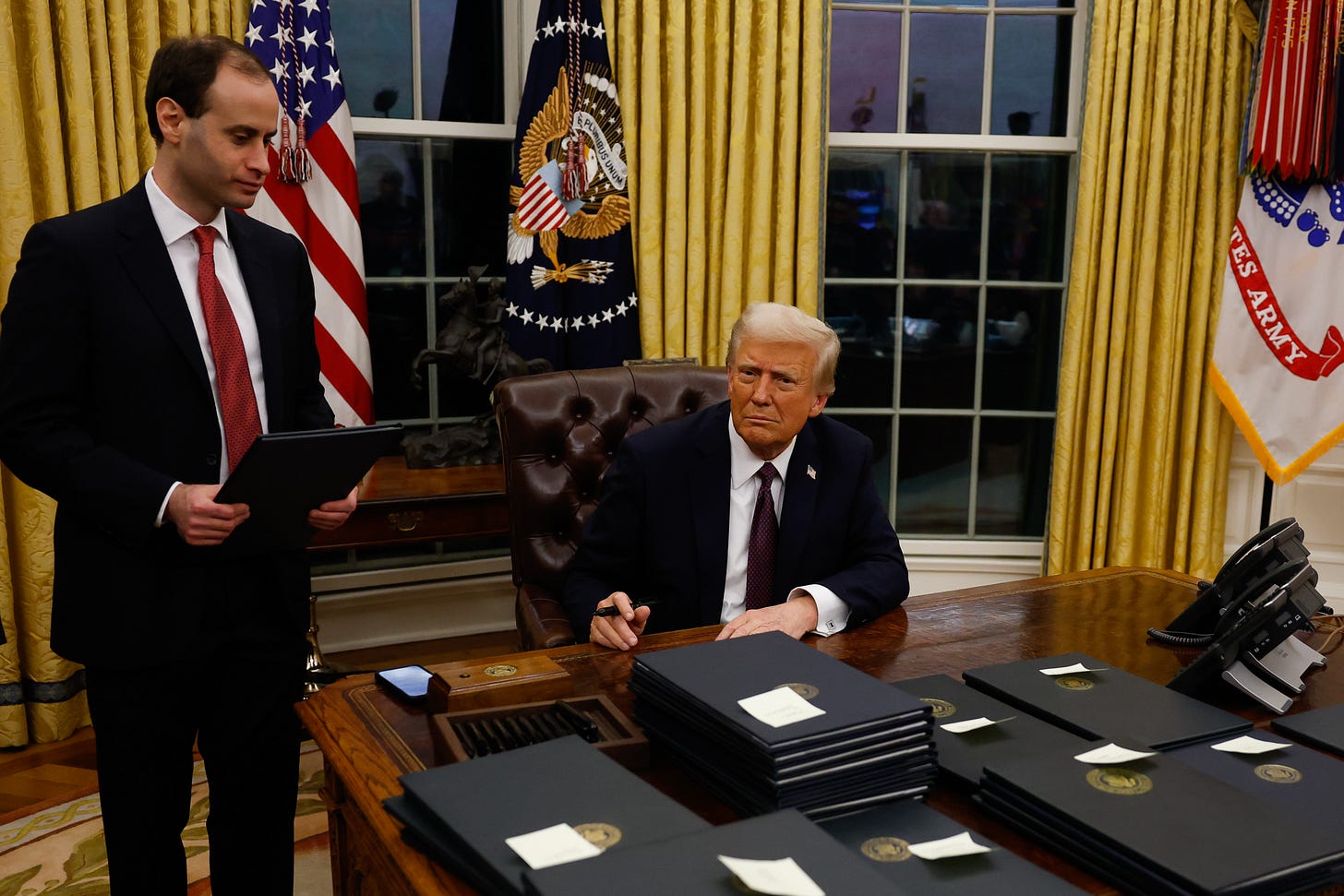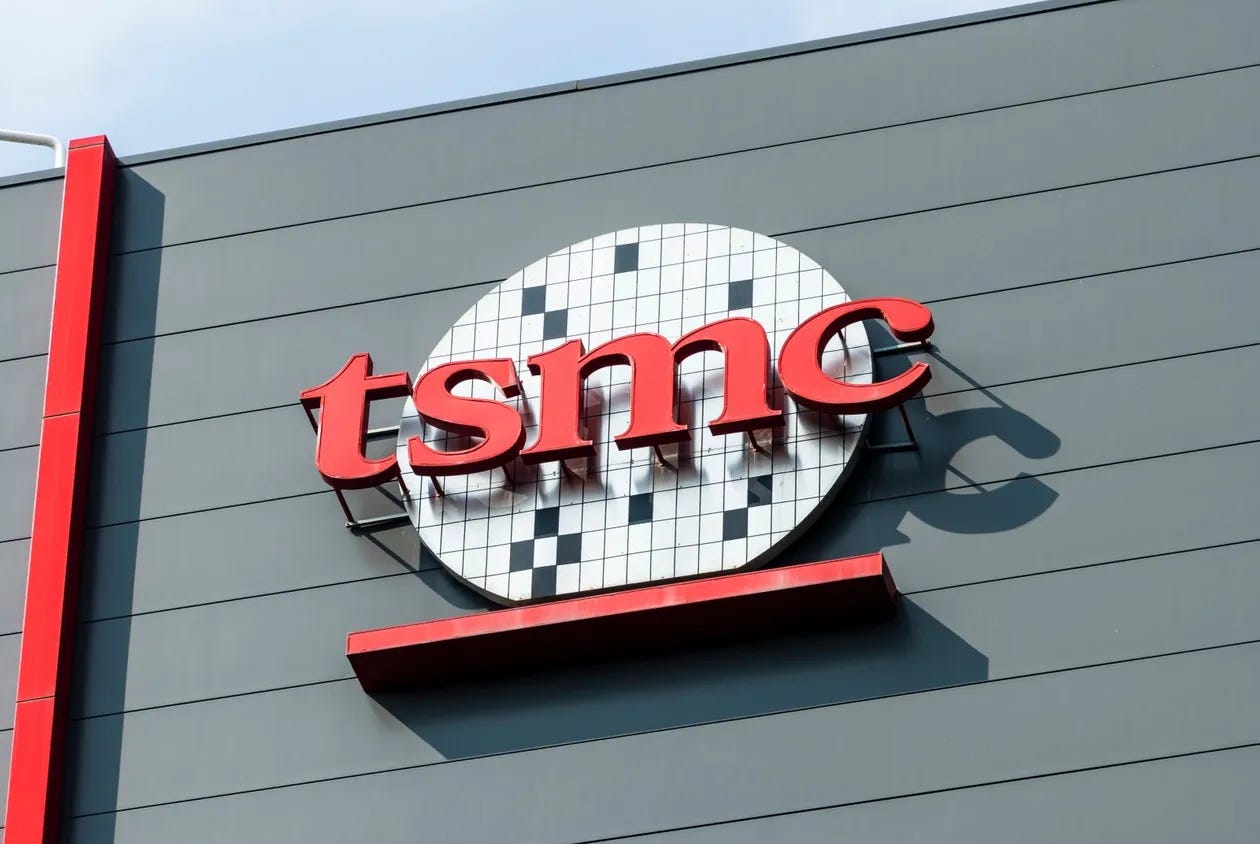TSMC Taking Over Intel’s Manufacturing? A High-Profile Dinner and an Insider Clues
Liang-rong Chen
Hi everyone,
Over the past week, both TSMC and semiconductor journalists like us have been through a crash course in shock therapy. “100% tariffs” and “TSMC acquiring Intel”—once thought to be absurd scenarios—now seem plausible under “Trump 2.0.”
As I scrambled to piece together accurate insights from countless rumors, someone tipped me off about a high-profile dinner gathering. Let’s start from there:
Source: Yu-Hsun Cheng
On the evening of February 15, a group of TSMC veterans gathered in Zhubei, filling five tables. Among those singing karaoke at the event were former TSMC CEO and current MediaTek CEO Rick Tsai(蔡力行), TSMC’s co-COO Y.P. Chin (秦永沛), retired former vice president Chien-Pang Chen(陳健邦), former senior VP Jian-Kuang Wang(王建光), and Vanguard International Semiconductor (VIS) CEO John Wei(尉濟時). The host of the evening was Hermes-Epitek’s (漢民科技) Vice Chairman Chin-yung Shu(許金榮), a former TSMC fab director, who invited many of his former colleagues.
The hottest topic of the night? The rumors that the Trump administration might “encourage” TSMC to take over Intel’s manufacturing division. On that very same day, The New York Times had reported that TSMC Chairman C. C. Wei had met in January with U.S. Commerce Secretary Howard Lutnick and Intel’s interim Executive Chairman Frank Yeary to discuss the matter.
Y.P. Chin, a key right-hand man to C. C. Wei who had just returned from TSMC’s Arizona plant, was immediately questioned—was he part of the negotiations?
Chin, TSMC’s top manufacturing executive, flatly denied it, stressing that if a factory isn’t designed by TSMC, TSMC won’t manage it—let alone take over operations.
A former TSMC executive familiar with him, however, remarked that Chin must be aware of the situation. But given the scale of the issue, even among old colleagues, he had to stay tight-lipped. “This isn’t baseless speculation. I believe discussions are happening, but neither side (TSMC nor the U.S.) has shown their cards yet,” he said.
When President Donald Trump was first elected, I asked Chip War author and Tufts University professor Chris Miller whether Trump, who had accused Taiwan of “stealing America’s chip industry,” would demand its return.
At the time, Miller assured me there was no need to worry—it was just campaign rhetoric. He believed Trump’s semiconductor policies wouldn’t deviate much from before. Many in the industry and academia shared this view.
But once Trump took office, the situation flipped overnight. On February 13, he ordered a review of “unfair” trade measures among partners, again calling out Taiwan for taking away U.S. chip business. He even floated the idea of imposing 100% tariffs as retaliation. “We want that business back in America. If they don’t bring it back, we’ll be very unhappy,” he warned. (More on the 100% tariff implications below.)
Amidst the heated discussions in Taiwanese and U.S. media about “TSMC’s increased commitment to the U.S.”—ranging from speeding up Arizona investments, relocating CoWoS advanced packaging, and technology transfer to Intel—rumors escalated to something once unthinkable: TSMC acquiring Intel’s manufacturing business.
Recently, both The New York Times and The Wall Street Journal have reported extensively on Intel’s interim chairman, Frank Yeary, a former investment banker with expertise in mergers and acquisitions, who appears keen to sell off Intel’s manufacturing division to “maximize shareholder value.” In the past two weeks, Intel’s stock has surged 32% as a result.
An executive at a leading IC design firm told me that Intel’s board likely ousted former CEO Pat Gelsinger late last year precisely to execute a plan to break up the company and sell off its money-losing manufacturing unit, which is expected to post a $13.4 billion loss in 2024.
TSMC Taking Over Intel’s Manufacturing: A Stallion Dragging an Elephant?
But I have many questions. Would turning Intel’s fabs—whose capacity is only about a quarter of TSMC’s—into pure foundries really align with Trump’s goal of “bringing chip production back to America”? Or is this merely wishful thinking from certain U.S. officials and Intel’s board?
After all, Trump is unlikely to accept a foreign company taking over such a critical American enterprise. Just days ago, he opposed Nippon Steel’s acquisition of U.S. Steel.
A foreign analyst, after consulting Washington lobbyists familiar with Trump’s administration, told me: “Trump cares about two things—money and face. If TSMC acquires Intel, Trump loses face.”
Photo: Getty
He believes TSMC needs to take the initiative and present a more aggressive investment plan. SoftBank’s Masayoshi Son is the benchmark. His Stargate project—an AI infrastructure collaboration with OpenAI and Oracle—boasts a $500 billion U.S. investment that perfectly satisfies Trump’s “money and face” criteria.
A former TSMC executive agreed. He stressed that TSMC should preemptively propose a viable plan that it can stomach, before the U.S. government dictates the terms. “Being first is key,” he said.
Even if it means transferring technology to Intel, forming joint ventures, or building new plants—however unappealing—it would still be preferable.
The worst-case scenario would be directly taking over Intel’s manufacturing. “That would be an extremely bad decision,” he warned.
This veteran factory leader put it bluntly: “TSMC taking over Intel would be like a stallion dragging an elephant. No matter how fast the horse runs, it won’t move the elephant.”
His remarks echoed Y.P. Chin’s stance: “If it’s not a factory designed by TSMC, TSMC won’t manage it.”
How Did Intel Become the “Bulky Elephant”?
Why do so many TSMC veterans recoil at the mere mention of Intel’s fabs?
A recent anecdote from a senior executive at a UMC-family company offers some clues.
Earlier last year, UMC announced a collaboration with Intel to develop a 12nm process platform—essentially repurposing Intel’s old CPU fabs for foundry work. But when UMC engineers arrived at Intel’s facilities, they were stunned:
“They’re still using ancient methods to do foundry!” the executive recounted.
How did Intel—once revered as a godlike presence in Taiwan’s semiconductor industry—become this cumbersome elephant?
The answer isn’t just about its troubles with 5nm and 3nm development. A crucial reason lies in a passage from Morris Chang’s autobiography.
I’ll explore this in our Tech Talk next week.
Real Impact of 100% Tariffs?
At the end of last year, a senior executive at a major Taiwanese semiconductor firm told me there was no need to panic over “Trump 2.0.” But during our recent conversation, he kept repeating: “Trump is terrifying.”
How will this latest “Trump 2.0 madness” play out? Here’s his analysis:
Q: When Trump first won, Chip War author Chris Miller and you both said “Trump 2.0” wouldn’t change much. Turns out everyone was wrong—by a mile?
A: Completely. And by multiples of what we expected.
Who would’ve thought Trump would launch a full-scale tariff war on day one? Biden’s approach—using subsidies and export controls—was gentler but took longer. Trump is impatient, and that’s a huge problem. TSMC has no choice but to ride it out and hope he’s gone in four years—unless he amends the Constitution.
Q: Vice President Vance recently declared that the most advanced AI systems must be designed and manufactured by Americans. Is this serious? The impact on Taiwan’s tech industry could be massive.
A: Yes, it has to be “American workers.” That’s exactly why the rhetoric from our government, talking about so-called “democratic supply chains” (Global Semiconductor Democratic Supply Chain Partnership Initiative) and U.S.-Taiwan “win-win cooperation,” is completely unrealistic.
Why did Trump get elected? Because he shattered that illusion. “Win-win cooperation” was a globalization-era concept—things like “U.S. design, Taiwan manufacturing.” You think that still works? Dream on. Trump suffered under that system, and he’s not going to let it continue.
There’s a deep frustration in American society—people are saying that Silicon Valley’s big corporations moved production to Asia, exploited cheap labor, and left American workers jobless while reaping the benefits of globalization. In the end, the U.S. has extreme wealth inequality—Apple is making a fortune, while the average American struggles. That’s why Trump was able to win.
Trump’s MAGA (Make America Great Again) agenda is about bringing manufacturing jobs back to American workers. All this talk about U.S.-Taiwan cooperation? To them, it’s absolute nonsense.
Didn’t Trump always say that Taiwan “stole America’s chip industry”? What he means is:
“American workers should have been the ones making chips for American companies. These chips were invented in America. The equipment was built by Americans. But how come TSMC end up producing over 90% of the world’s advanced chips?”
Q: Trump is now threatening to impose a 100% tariff on Taiwan-made chips. On February 18, he announced a one-year buffer period, starting with a 25% tariff in April before rapidly increasing. Based on current information, the industry believes it could still rise to 100% within a year. Will this be a major blow to TSMC?
A: A lot of people in the media don’t understand the kind of tariff Trump is imposing this time. This is called a component tariff, meaning it’s a tax on importers, not exporters. Even if a company imports a smartphone, the importer will have to report to customs exactly how much of it was made in Taiwan and the value of the chips inside.
So when some media reports say “TSMC will raise prices,” they clearly don’t get it.
For example, if you import an iPhone, Apple will have to declare the cost of its key components—its main chip, WiFi chip, etc. Even if TSMC makes the chips and ASE’s Korea plant does the packaging, that doesn’t matter. Apple will still have to break down exactly how much of the value came from Taiwan’s wafer fabrication.
Why did Trump choose 100% tariffs? How did he set this number? It’s simple. He likely took Morris Chang’s statement that U.S. production costs are twice as high as Taiwan’s and used that as his benchmark.
Trump wants to artificially increase Taiwan’s production costs beyond U.S. levels so that customers will put pressure on TSMC to relocate manufacturing to America.
For instance, if the TSMC-made main chip in an iPhone costs $50, Apple would have to pay $50 in tariffs to the U.S. government.
For TSMC itself, this doesn’t directly impact their pricing—but it does pressure its customers. Since Taiwan-made chips will suddenly become a lot more expensive, customers will demand lower prices from TSMC to offset the tariff burden.
Trump is deliberately making customers feel the pain, forcing them to push TSMC to relocate production.
TSMC’s response? A firm NO—because their advanced processes are irreplaceable.
So the real threat to TSMC now is Samsung. Just like how the U.S. crushed Japan’s semiconductor industry in the past, if Taiwan’s tariffs differ from Korea’s, TSMC is in trouble. Customers will shift orders to Samsung, since Samsung also has advanced process.
If the U.S. imposes equal tariffs on both Taiwan and Korea, then TSMC remains unfazed.







How does it help Musk to take over IFS if the foundry can’t make Nvidia chips? It simply doesn’t have the capability. Wouldn’t it make better sense to invest in TSMC’s Arizona expansion and require TSMC to spin off into a US listco?
Here's what's really going to happen: MIGA = Make Intel Great Again
Here's the win-win situation for everyone.
Musk gains control of Intel IFS's 18A process and chips and gets as many high end semiconductors as he needs to achieve AGI superiority and beats all AI competitors, especially Altmans openAI, which Musk will especially relish. Only Musk can pull that off as he's clearly proven with all his other impossible-goal but highly successful companies. Sure, he's got his hands full. But, in addition to all his other unmatched talents, he's also the best talent scout, delegator, manager from an arm's length, and money raiser on the planet. After all, he is a rocket scientist and close to being a brain surgeon as well with his Neuralink company he owns.
inXtel can produce chips for the USA military and other companies that need high end chips
USA is less reliant on fragile Taiwan for chips, and less threatened by China putting a stranglehold on Taiwan and chip exports.
Trump has more leverage in negotiating deals with China about everything else. That explains Trump's postponing making a TikTok decision as well.
Musk's private xAI investors get a great ROI when they own part of Intel (IFS) whose stock will skyrocket as a result of the Musk Midas touch phenomenon. By the way, NVIDIA is an investor in xAI. Jensen Huang is not taking any chances and hedging his bets, as he is dependent on Taiwan to make the hot NVIDIA H100, H200 and Blackwell chips, and fearful of what China might do to impede that.
Intel shareholders will also get shares in high flying xAI merger with IFS, so shareholders will vote for the merger
Intel will own a piece of the merged company, so the board will vote for the merger, and Intel will probably get some much needed cash as well
The merged company raises money from stock sales and from Saudi and Dubai investors since the merged company will need at least $50 billion to get 18A on course and humming
Musk will remain the largest xAI+IFS shareholder bringing him closer to becoming the first trillionaire, with no one a close second. Forbes will have to publish a supplement to its Billionaire issue; Trillionaire, but with only 1 page.
As Elon Musk frequently says, "the most entertaining outcome is most likely." https://x.com/cb_doge/status/1890929064510103863
An xAI merger with the Intel IFS division would certainly be most entertaining, the best for Musk, the best for Trump, the best for the USA, the worst for China.
Musk just released Grok 3 a few days ago and he says it's the best AI on the planet. It runs on a cluster of 100,000 high end networked NVIDIA chips. Musk is in a race with his competitors to reach AGI. In the past he has posted that he needs to cluster 200,000 to a million NVIDIA chips (to reach AGI). In a news conference on X at the Grok3 release, Musk said he is now in the process of networking 200,000 NVIDIA chips. Musk therefore needs an uninterrupted source of the highest end chips. NVIDIA can't make enough chips (all made by Taiwan Semiconductor). Additionally the NVIDIA chips cost about $25,000 - 40,000 each. Musk I'm sure gets a volume discount, but if he can make the chips in his own xAI-IFS company, he'll save billions of dollars, and we know he is a fanatical cost cutter. The only way he can do that is by owning the chip design processes and manufacturing fabs at IFS. It's not as hard as catching a reusable Starship on Mechazilla.
I believe that the xAI-IFS merger will be announced after the Senate approves Kash Patel as head of FBI, which happened yesterday. IOnce Patel is approved Trump will have all the people he wants in his cabinet, and Democrats won't be able to do much about Musk's increased power.
Should be announced soon: xAI + Intel/IFS = inXtel.